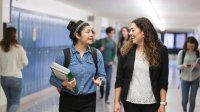Encouraging Teens to Develop Self-Regulation Skills
When students understand their individual strengths, they can advocate for themselves and meet their own needs.
Your content has been saved!
Go to My Saved Content.Your bulletin boards are ready, rosters assigned, and the opportunity to set a new tone for the year awaits. It’s your chance to establish common classroom language and routines that promote self-regulation and self-awareness—two keys to student success. In essence, you get to prepare your students to own their learning experiences, creating a climate where students embrace and implement accommodations and innovations of Universal Design for Learning (UDL) and experience the benefits of differentiation.
Set the Tone and Boost Students’ Knowledge of the Brain
Normalizing the diversity of brains, their needs, and respective accommodations is a foundational first step. You can help students understand their brain development through videos, drawings, and lessons. These resources provide neutral language and context for what they start to observe in themselves. Next, establish that using a variety of strategies and accommodations as a learner is the norm, not the exception, since brains have diverse needs.
Offer relatable, real-life examples of learning and succeeding in multiple ways. You can ask students to consider how parts of their brain allow them to receive, organize, and recall information. More specifically, how does their brain perform a task like reading, playing the piano, or playing soccer?
You determine how your classroom space can be flexible for all kinds of learners and can communicate useful options to your students. In your efforts to set the tone and foster students’ understanding of their strengths—as they relate to their own physiological, emotional, and learning needs—you can implement some self-discovery classroom activities such as the following:
- Drawing a picture of their brain; the goal of this activity is to gather information about student understanding of brain development and their inner voice as it pertains to their learning abilities.
- Asking questions about their responses to the above with a focus on the relationship between students’ inner voice and learning.
- Prompting them to compare a learning experience with that of one of their special interests and find overlap (e.g., “when presented with visual spatial information, it’s easier to understand because of my interest in gaming”).
- Asking students to complete a strengths survey that also illuminates learning strategies such as visualizing, making associations, and rehearsing information.
- Incorporating self-reflection prompts that touch on content or focus on metacognition. (Were you engaged in class today? Why or why not? When you review your work, what do you notice that you can do differently? How did you adjust your focus when you needed to? What did you notice about your learning [or group work, writing, or other thinking task] today?)
Teach Students How to Express Awareness and Meet Their Own Needs
As students become aware of what their brains and bodies need as learners, the next step is to empower them with the language to effectively express those needs. Consider encouraging students to adopt sentence frames that describe a variety of needs in declarative language. For example: “Sometimes my brain needs…”; “I have a brain that learns best when…”; or “Right now, my body is feeling or needing….”
This practice also makes space for UDL tools and innovations, since students are able to take ownership of and share their experience. For example, a student who recognizes that their brain understands what they see and read more than what they hear may be more willing to ask for and use captions during lectures or videos. Or, a student who knows their focus is sharper when they’re able to move a bit may ask for a place to move or innovate a stealthy fidget, like a quiet piece of Velcro or even a paperclip in the pocket, to serve their own needs in class.
You may also want to address the friction that arises when students recognize a clash between their identified needs and what the classroom environment demands. For example, students may have bodies that need to move a lot but may be in a testing situation in which movement is not allowed. Another student may start to recognize that their brain struggles with managing focus, which is widely required of students.
Allow your students to explore this friction and encourage them to create solutions to move through it. You’ll be amazed at the ways students innovate to meet their own needs, even within the confines of learning challenges or classroom expectations. Students who are not yet able to identify potential solutions may be encouraged to hear teachers share other students’ examples or may benefit from brainstorming strategies with a trusted adult.
Extend Self-Regulation Tools
When students have the language to explain how they learn and how they feel about learning, they are better able to self-regulate. Given that self-regulation is a critical factor in learning and problem-solving, it is beneficial for students to continue to hone their self-regulation skills. Teachers can demonstrate and support students through a variety of self-regulation approaches:
- Mindfulness routines (short breathing or focusing activities)
- Making real-time adjustments based on body feedback that they’re dysregulated (taking a break, asking for help, etc.)
- Providing strategies for managing physical or kinesthetic energy (allow use of soft fidgets, standing, moving while processing, etc.)
- Using positive self-talk (provide prompts or visual reminders for context)
- Supporting students with setting realistic and measurable personal goals
- Helping students with the process of self-reflection
Meeting the needs of every student can feel overwhelming, but you aren’t in it alone. Students are self-experts, and you can tap into their incredible potential by helping them learn about their brains, how to express their needs, and how to keep exploring strategies to maximize their school experience. Ultimately, you empower your students to ask for support and implement strategies that boost learning.
